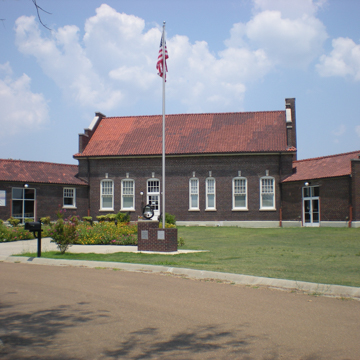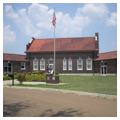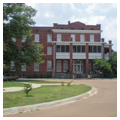Brinkley was a railroad town laid out in the winter of 1869–1870 as a stop on the Memphis and Little Rock Railroad and named for Robert Brinkley, president of the railroad. This station faces the intersecting railroad grades of two competing railroad lines: the Chicago, Rock Island and Pacific Railroad and the Cotton Belt. The one-and-a-half-story passenger building runs diagonally to the tracks while the two flanking single-story freight sections run parallel to their respective railroad lines. The station was built by the Chicago, Rock Island and Pacific in its signature Mediterranean Revival style in red brick, with a red tile roof, stepped brick parapet-gable end walls, concrete coping, and round-arched windows. The interior retains all of its historic fabric. Passenger service here ended in 1967, and Union Pacific deeded the station to the City in 2001. Later leased to the Central Delta Historical Society, the station serves as a county museum. The depot sits within what is now a historic district named the Lick Skillet Railroad Work Station, comprising the station and three-story former hotel. The Rusher Hotel (1915; 127 W. Cedar Street) served Union Station and initially had its principal front facing the station. Today a small park is between the two buildings.
You are here
Central Delta Depot Museum (Union Station)
If SAH Archipedia has been useful to you, please consider supporting it.
SAH Archipedia tells the story of the United States through its buildings, landscapes, and cities. This freely available resource empowers the public with authoritative knowledge that deepens their understanding and appreciation of the built environment. But the Society of Architectural Historians, which created SAH Archipedia with University of Virginia Press, needs your support to maintain the high-caliber research, writing, photography, cartography, editing, design, and programming that make SAH Archipedia a trusted online resource available to all who value the history of place, heritage tourism, and learning.





